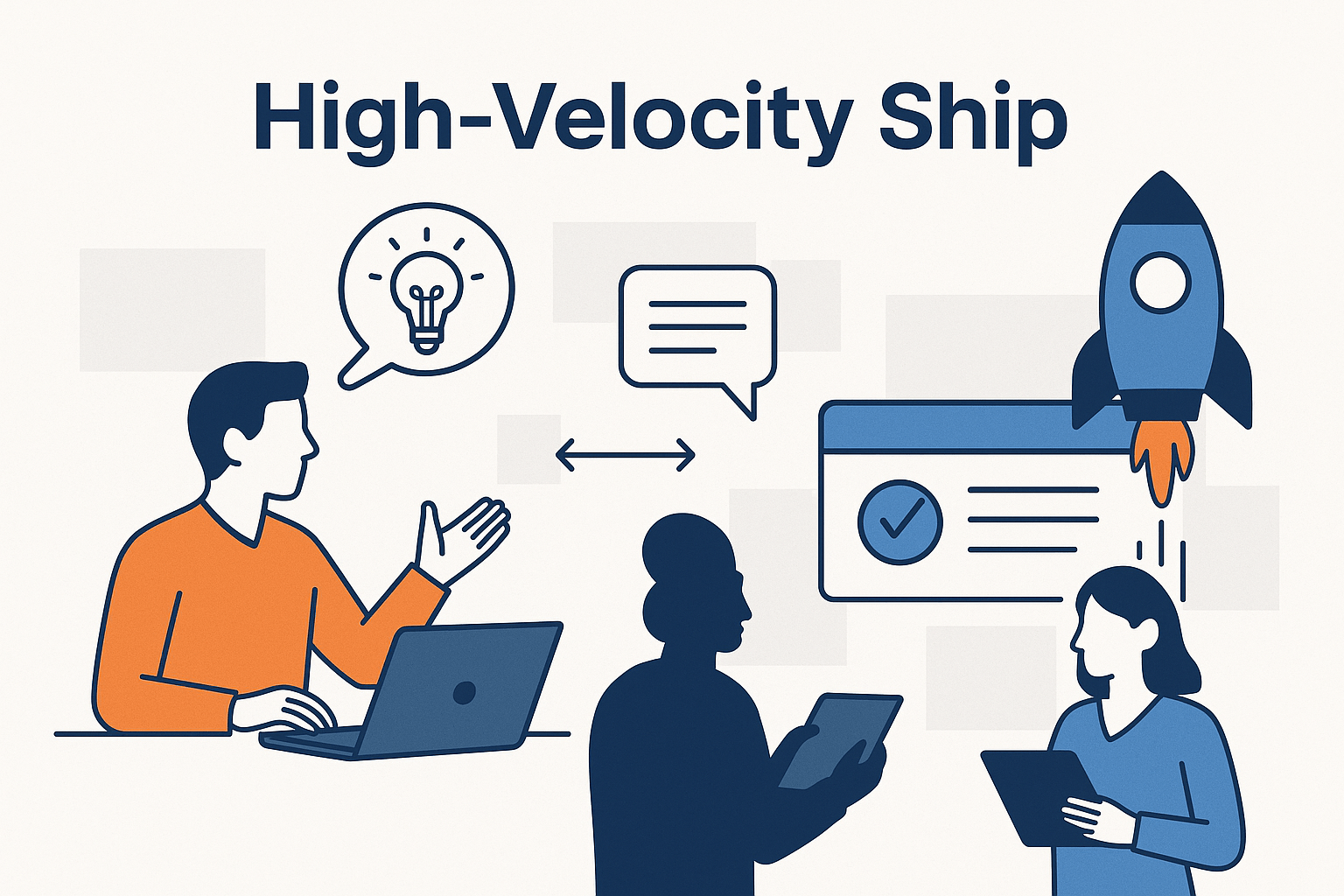
Discover how high-velocity shipping transforms ideas into same-day functional apps using AI-driven business analysis and rapid prototyping.

If you spend enough time around software teams, you’ll hear the word “ship” thrown around a lot. In simple terms, “ship” means delivering something that works. Not perfect. Not complete in the enterprise sense. Just real, functional, usable by someone, somewhere. It is the opposite of endless planning. It is the antidote to analysis paralysis. To ship is to put something in the hands of the business so they can react, learn, refine, and move forward.
Now, let’s talk about high-velocity ship.
High-velocity ship is the ability to move from idea → conversation → working software faster than most organisations can schedule a meeting. It breaks the traditional assumption that delivery must be slow, linear, and bogged down by layers of intermediaries. Instead, it embraces an approach where business, product, AI, and engineering come together in a tight loop that compresses days into hours and hours into minutes.
This is not a theoretical future state. This is what we do today.
We’ve built a business model designed for modern speed: bring us your idea, your business problem, your napkin sketch, or even just a loose concept, and we’ll sit down with you – in person or online – and extract the essence of what you’re trying to achieve. The extraction process matters. It’s its own discipline. It’s digital business analysis done at high fidelity and high yield.
Our process starts with the conversation, but not the typical requirements workshop that turns into a documentation marathon. Instead, we ask the kinds of questions that unlock clarity fast. We push on assumptions. We look for constraints. We frame the business outcome before the technology. And then we translate everything into a narrative that AI models can act on without hesitation.
Once the problem takes shape, we move straight into build mode.
And this is where the real magic happens.
With the right stack, the right AI tools, and the right prompting discipline, we can turn around a concept demo live during the conversation — or if not live, certainly within the same day. A custom-built mini-app, a proof-of-concept workflow, or a fully functional demo that actually works in a browser, not just as a slide.
This isn’t smoke and mirrors. These are actual working prototypes that business stakeholders can interact with immediately. And perhaps more importantly, they can share the demo with their teams to gather feedback before anyone invests in a long delivery cycle.
This model wasn’t realistic three months ago. It relied on technology that simply didn’t exist at production quality: real-time voice agents that can ask intelligent questions, agentic LLMs capable of multi-step planning, and models that can hold extended context while generating high-quality code.
It also required a maturity curve on our end. Teams need hundreds of hours of experimentation to understand how to prompt well, how to structure context, how to chain AI agents together, and how to standardise the artefacts that make acceleration possible.
The reason we can achieve high-velocity ship today comes down to four compounding assets:
When these pieces work together, the friction disappears. You can go from nothing to something real incredibly fast.
A working demo is not production code. It’s not compliant with the organisation’s security policies. It’s not built for scale, resilience, or maintainability. And that’s fine. That’s not the point.
High-velocity ship is about clarity.
It’s about unlocking business imagination.
It’s about aligning stakeholders on the thing they think they want before an engineering team commits months of effort.
And here’s where it loops into Spec Driven Development.
We’ve trained our product managers and analysts — many from non-technical backgrounds — to use GitHub Copilot, navigate the codebase, create branches, draft PRDs, and contribute directly alongside engineers. The demos we ship in a day often become foundational artefacts for the full engineering team. They feed into PRDs, agents.md files, architectural notes, and test plans.
This is where Spec Driven Development shines: when the early artefacts are clear, the engineering cycles later become dramatically faster because the hard thinking is already done.
High-velocity ship accelerates the conversation.
Spec Driven Development accelerates the build.
Together, they form a modern delivery loop that outpaces traditional digital teams by a wide margin.
One of my favourite parts of this process is the whiteboard moment.
We often sit in a room with a handful of business stakeholders, scribble ideas across a whiteboard, take photos of the mess, and pass them straight into our AI tools. What once required a BA to transcribe and interpret now becomes instantaneous context for the LLMs.
Our voice AI agent then asks clarifying questions — sometimes better than a human facilitator — and captures assumptions, decision points, and intended outcomes. That transcript becomes a requirements document. That document becomes a plan. The plan becomes code. And the code becomes a demo.
This is how digital problem-solving should feel: collaborative, fast, fluid, and generative.
Velocity without accuracy is chaos. Accuracy without velocity is bureaucracy. High-velocity ship strikes the balance.
It lets businesses validate ideas without large upfront investment.
It lets teams experiment and explore.
It lets stakeholders touch something real before the organisation makes big commitments.
It gives the engineering team clarity instead of assumptions.
And, frankly, it revives the joy of building. The sense of creative flow. The feeling of seeing software emerge from conversation at the speed of thought.
This is not a temporary trend. The combination of real-time voice models, agentic LLMs, code-gen systems, and shared organisational context is pushing software development into a new era.
High-velocity ship is how modern digital teams will operate.
Spec Driven Development is how they will industrialise the output.
Together, they form the next evolution of agile.
We’re simply early. And we’ve built a repeatable model to help businesses experience this transformation now, not five years from now.